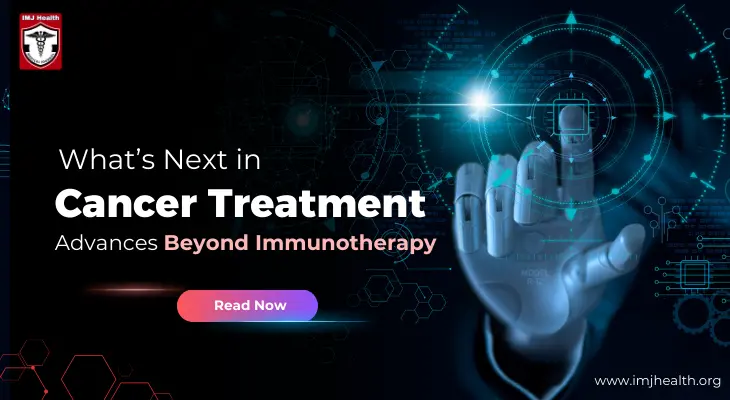What’s Next in Cancer Treatment? Advances Beyond Immunotherapy

Beyond immunotherapy, the future of cancer treatment includes precision medicine, gene therapy, nanotechnology, and AI-driven drug discovery. These cutting-edge innovations aim to improve survival rates, reduce side effects, and personalize treatment for each patient. As research progresses, cancer care is evolving towards more effective and targeted therapies.
What’s Next in Cancer Treatment? Advances Beyond Immunotherapy
Cancer treatment has come a long way, with immunotherapy revolutionizing how we fight the disease. However, not all patients respond to immunotherapy, and new treatments are needed. Scientists are working on advanced therapies beyond immunotherapy that can improve survival rates and reduce side effects. This blog explores the next generation of cancer treatments, including precision medicine, gene therapy, targeted drug delivery, and other cutting-edge research.
1. Precision Medicine: Personalized Cancer Treatment
Precision medicine focuses on tailoring treatments to an individual’s genetic makeup. Instead of a one-size-fits-all approach, doctors analyze a patient’s DNA to determine which treatment will work best.
How It Works:
- Doctors use genetic tests to find mutations in cancer cells.
- Treatments are selected based on a patient’s genetic profile.
- This approach improves effectiveness and reduces unnecessary side effects.
Example:
- In breast cancer, HER2-positive patients benefit from Trastuzumab (Herceptin), a drug designed for this specific type of cancer.
2. Targeted Therapy: Attacking Cancer Cells Directly
Targeted therapy uses drugs that focus only on cancer cells while sparing healthy ones. Unlike chemotherapy, which affects the whole body, targeted therapy blocks specific proteins or genes that help cancer grow.
Types of Targeted Therapy:
- Angiogenesis Inhibitors: Stop tumors from forming new blood vessels (e.g., Bevacizumab).
- Signal Blockers: Interfere with cancer cell communication (e.g., Imatinib for leukemia).
- Hormone Therapy: Used in cancers like breast and prostate cancer to block hormones that fuel tumor growth.
Example:
- Gleevec (Imatinib) revolutionized the treatment of chronic myeloid leukemia (CML) by targeting a specific gene mutation.
3. Gene Therapy: Fixing Cancer at the DNA Level
Gene therapy aims to repair or replace faulty genes that cause cancer. Scientists are exploring ways to edit genes using advanced technology like CRISPR to stop cancer from growing.
How It Works:
- Scientists modify genes to make cancer cells self-destruct.
- Healthy genes are inserted to replace defective ones.
- Some methods boost the immune system to recognize and kill cancer.
Example:
- In 2022, researchers successfully used gene therapy for leukemia, helping patients who did not respond to chemotherapy.
4. Nanotechnology: Using Tiny Particles to Kill Cancer
Nanotechnology involves using microscopic particles (nanoparticles) to deliver drugs directly to cancer cells. This method increases drug effectiveness while reducing side effects.
Benefits of Nanotechnology in Cancer Treatment:
- Delivers chemotherapy only to cancer cells, sparing healthy cells.
- Enhances imaging for early cancer detection.
- Improves radiation therapy precision.
Example:
- Doxil (a nanoparticle-based chemotherapy drug) delivers medication directly to tumors, reducing damage to healthy tissues.
5. Cancer Vaccines: Preventing and Treating Cancer
Cancer vaccines train the immune system to recognize and destroy cancer cells. Some vaccines prevent cancer, while others help treat it.
Types of Cancer Vaccines:
- Preventive Vaccines: HPV vaccine reduces cervical cancer risk.
- Therapeutic Vaccines: Boost the immune system to fight existing cancer (e.g., Provenge for prostate cancer).
Example:
- The HPV vaccine prevents cervical cancer caused by the human papillomavirus (HPV).
6. Artificial Intelligence (AI) in Cancer Research
AI is transforming cancer research by analyzing large amounts of medical data to detect cancer early and suggest treatment plans. AI-driven tools help doctors make faster and more accurate decisions.
How AI Helps in Cancer Treatment:
- Identifies tumors in medical scans faster than doctors.
- Predicts how a patient will respond to treatment.
- Designs new drugs using AI-powered simulations.
Example:
- Google’s AI DeepMind can detect breast cancer in mammograms with better accuracy than radiologists.
7. Tumor-Treating Fields (TTFields): A Non-Invasive Treatment
TTFields use electric fields to slow cancer cell division. Patients wear a device that delivers these fields to the tumor area without surgery or medication.
Benefits:
- Painless and non-invasive.
- Can be combined with chemotherapy or radiation.
- Minimal side effects.
Example:
- Optune is a TTFields device approved for glioblastoma (a type of brain cancer).
8. Stem Cell Therapy: Regenerating Damaged Cells
Stem cell therapy is used to replace damaged blood-forming cells in cancer patients undergoing aggressive treatments like chemotherapy and radiation.
How It Works:
- Healthy stem cells are injected into the body.
- These cells develop into new blood and immune cells.
- It helps patients recover faster after treatment.
Example:
- Bone marrow transplants are a form of stem cell therapy used for leukemia and lymphoma patients.
9. Metabolic Therapy: Starving Cancer Cells
Scientists are exploring ways to block cancer cells from using nutrients to grow. Some treatments target the cancer cell metabolism, starving the tumor without harming normal cells.
Example:
- Dichloroacetate (DCA) is being tested as a drug to block cancer cell energy production.
10. Combining Treatments for Maximum Effect
Doctors are now combining different treatments, such as targeted therapy with chemotherapy or immunotherapy with gene therapy, to achieve better outcomes.
Example:
- Some lung cancer patients receive a mix of targeted drugs and immunotherapy to increase survival rates.
Cancer research is moving beyond immunotherapy to include revolutionary treatments like precision medicine, gene therapy, and AI-driven solutions. These advancements aim to improve survival rates, reduce side effects, and personalize treatment for every patient.
With ongoing research and technology, the future of cancer treatment looks hopeful. Scientists are working to develop less toxic, more effective therapies that could one day lead to a world where cancer is no longer a deadly disease.
How IMJ Health Can Help You in Cancer Research
If you are researching new cancer treatments, IMJ Health can help you publish your work and reach a global audience.
- Fast & Transparent Peer Review – Get expert feedback quickly.
- Global Visibility – Your research will be accessible worldwide.
- Open-Access Publishing – Maximize the impact of your findings.
- Author Support Services – Assistance with manuscript formatting and submission.
Join IMJ Health to share your innovative cancer research with the scientific community!
FAQs
Ques. 1. What is the most promising cancer treatment beyond immunotherapy?
Ans: Precision medicine and gene therapy are among the most promising new treatments.
Ques. 2. How does AI help in cancer treatment?
Ans: AI helps detect cancer early, predicts treatment responses, and designs new drugs.
Ques. 3. What is targeted therapy?
Ans: Targeted therapy blocks specific genes or proteins that help cancer grow, reducing side effects.
Ques. 4. Can cancer vaccines prevent all cancers?
Ans: No, but vaccines like the HPV vaccine can prevent certain cancers.
Ques. 5. What is Tumor-Treating Fields (TTFields)?
Ans: TTFields use electric fields to stop cancer cell growth without surgery or drugs.
Contact Medical Journal: IMJ Health
- Website: www.imjhealth.org
- Editor-in-Chief: Dr. Kusum Lata Gaur | MBBS, MD(PSM), CIC (IGNOU), PGCHFWM
(NIHFW) (WHO Fellow IEC)
Professor, PSM & Member of Research Review Board | SMS Medical College, Jaipur (Rajasthan) India - Editor-in-Chief Email ID: info@imjhealth.org
- General Support Email: info.imjh@gmail.com
- Contact us on WhatsApp: Chat Now : +91-7665235235

 October 2025 Articles
October 2025 Articles Submit Article
Publication Fee
Research Areas
Guidelines for Authors
Process of
Publication
Journal Importance
Journal Indexing
Journal Polices
Digital
Identification Number
FAQs
Submit Article
Publication Fee
Research Areas
Guidelines for Authors
Process of
Publication
Journal Importance
Journal Indexing
Journal Polices
Digital
Identification Number
FAQs
| Citation Indices | All | Since 2019 |
| Citation | 280 | 209 |
| h-index | 7 | 7 |
| i10-index | 3 | 1 |
| Acceptance Rate (By Year) | |
| Year | Percentage |
| 2024 | 8.17% |
| 2023 | 10.84% |
| 2022 | 9.14% |
| 2021 | 11.26% |
| 2020 | 11.8% |
| 2019 | 10.3% |
| 2018 | 8.65% |
| 2017 | 12.9% |
| 2016 | 10.9% |
| 2015 | 12.5% |
